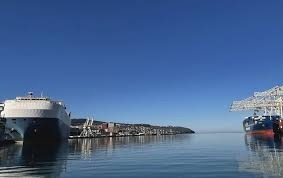Europe is at a pivotal moment in its transition to cleaner energy. Expanding offshore wind power has become a central plank in the region’s decarbonisation strategy and energy-security agenda. Yet at the same time, European policymakers and industry players are increasingly concerned about how much of the offshore wind value chain is dominated by China. That dominance raises strategic, economic and security questions that could complicate Europe’s green ambitions.
The Rise of Offshore Wind in Europe
Europe is at a pivotal moment in its transition to cleaner energy. Expanding offshore wind power has become a central plank in the region’s decarbonisation strategy and energy-security agenda. Yet at the same time, European policymakers and industry players are increasingly concerned about how much of the offshore wind value chain is dominated by China. That dominance raises strategic, economic and security questions that could complicate Europe’s green ambitions.
The Rise of Offshore Wind in Europe
Northern Europe in particular has embraced offshore wind as one of its most promising green technologies. The sea-beds of the North Sea, Baltic and Irish Sea offer high wind-speeds and large scope for large turbines. According to data cited by Reuters, Europe expects to add about 43 gigawatts (GW) of offshore wind capacity over the next five years, which would nearly double its current capacity of around 80 GW.
The strategic logic is strong: the war in Ukraine underscored the vulnerability of Russian gas supplies, prompting Europe to prioritise domestic and renewable energy production. Offshore wind can help reduce dependence on imported fossil fuels, while also generating jobs and industrial growth.
China’s Dominance in the Supply Chain
Despite Europe’s ambition, the supply-chain reality tells a different story. China has built a formidable wind-technology manufacturing machine. It dominates key inputs such as permanent magnets and rare-earth materials, and Chinese turbine makers increasingly compete internationally. For example, Germany’s economy ministry reports that China supplies around 90% of permanent magnets used in offshore wind turbines and related technology.
Chinese-manufactured turbines can cost 30-40% less than their European equivalents, according to consultant Rystad Energy. This cost advantage has given Chinese OEMs (original equipment manufacturers) a significant competitive edge in global markets.
That price gap, combined with China’s scale and rapid innovation (e.g., very large turbine models) means Europe risks being locked into relying on non-European technology and components — even as it tries to build its own domestic industry.
The Dual Dilemma: Opportunity vs. Risk
Europe’s situation presents a dual dilemma:
- Opportunity: Using cheaper Chinese components and turbines might accelerate deployment and cut costs. For nations trying to scale up offshore wind quickly, the economics are tempting.
- Risk: Reliance on non-European supply chains introduces vulnerabilities: strategic dependencies, limited local industrial benefit, security concerns (especially with digital and operational control systems), and the erosion of Europe’s own manufacturing base.
For example, a German-government-commissioned report warns of potential risks from Chinese-supplied turbines, including cyber-vulnerabilities or the possibility of operational control being exploited. Similarly, in the UK, Chinese firm Ming Yang Smart Energy announced plans to invest in a turbine plant in Scotland—a deal applauded for job creation, yet raising questions of foreign control over critical infrastructure.
Industrial and Geopolitical Stakes
Several interlocking stakes are at play:
- Industrial competitiveness: If Europe outsources too much of the manufacturing, it may lose out on jobs, value-add, and the ability to scale innovation. A strong domestic supply chain ensures more resilient cost-structure and technological leadership.
- Energy security: Offshore wind is increasingly part of Europe’s long-term energy system. If important components or turbines come from external actors, Europe’s control over its energy future weakens.
- Geopolitical strategy: Competition with China in green technology is already a strategic frontier. The European Union (EU) has initiated investigations into Chinese subsidies for green industries, noting unfair competitive advantages.
- Technology and data security: Wind-turbine farms increasingly incorporate digital control systems and sensors. Foreign OEMs supplying software and hardware raise questions about who holds operational or data access rights.
Germany’s roadmap, for instance, aims by 2035 to source 50% of permanent magnets from non-Chinese sources, signalling an explicit move to “de-risk” reliance on China.
The Pressure on Europe’s Domestic Industry
Europe’s own offshore wind manufacturing sector is under increasing pressure. Several indicators illustrate that:
- European turbine manufacturers are postponing investment decisions due to uncertain demand, policy headwinds and competition from China.
- Price differentials mean Chinese turbines undercut European ones by a large margin, making it difficult for European firms to win contracts purely on cost.
- Infrastructure and permitting remain challenging: many offshore wind projects face bottlenecks in port capacity, installation vessels and grid connection.
As a result, even as Europe aims to scale up offshore wind deployment, it risks sending the manufacturing opportunities and value-chains offshore — to China or other regions.
Policy Responses and Industrial Strategy
European institutions have begun responding. The Net-Zero Industry Act (NZIA) and the “Clean Industrial Deal” are legislative tools aimed at boosting domestic clean-tech manufacturing and reducing dependencies.
The EU’s Wind Power Package emphasises strategic public procurement, local content criteria and financial support for manufacturing. For example, the European Investment Bank (EIB) and national bodies are investing hundreds of millions into battery, cable and component makers in Europe.
Furthermore, countries like Germany are setting explicit targets to reduce import-dependence on specific components and to establish “alternative sourcing” partnerships with nations like Australia and Japan.
The Tightrope: Cost, Speed and Sovereignty
Europe has to walk a fine line:
- Cost and speed favour utilising the most cost-efficient supply chains (often Chinese).
- Sovereignty and resilience demand building and protecting domestic manufacturing and secure supply-chains.
This tension is particularly acute in offshore wind, where the scale of investment is huge, time-to-deploy is long, and maintaining industrial capacity matters for regional jobs and exports.
One practical dilemma: should a project accept Chinese turbines to deliver fast and cheap capacity? Or should it delay and invest in more expensive European manufacturing, to safeguard industrial base and strategic autonomy?
What Happens if Europe Fails?
If Europe does not act:
- It may lose much of the offshore wind manufacturing value-chain to China, undermining European industrial competitiveness.
- Deployment may slow or cost more as local manufacturing remains under-developed — ironically raising Europe’s dependency on external supply.
- Strategic vulnerabilities increase: reliance on third-party technology in critical infrastructure can reduce control and expose the system to risks (cyber, data, supply-shock).
- Europe’s ambition to be a global leader in clean-tech could fade, as geography, policy complexity and cost disadvantage hold back momentum.
What to Watch in the Coming Years
Key indicators to monitor include:
- The outcome of major offshore wind tenders: whether European OEMs win large contracts or Chinese suppliers dominate.
- Deployment of Europe’s domestic supply-chain infrastructure: factories for blades, nacelles, rare-earth magnets, control-system software.
- Government policy moves: supporting local manufacturing, requiring local content, regulating foreign participation in critical-infrastructure projects.
- Beijing’s strategy: Chinese OEMs expanding into Europe, Chinese supply-chain leverage growing in Western renewables.
- Grid expansion and installation-vessel availability in Europe – how infrastructure bottlenecks affect rollout.
Conclusion
Europe’s offshore wind sector embodies many of the dilemmas inherent in global green transitions. On one hand, it offers one of the most promising pathways to decarbonisation, energy security and industrial growth. On the other, it exposes Europe to strategic dependencies, cost pressures and global competition, especially from China.
Rather than a simple choice between “buy cheap” or “buy local,” Europe must craft a nuanced strategy: accelerating deployment while safeguarding its own industrial base and strategic autonomy. The decisions made now — about manufacturing, procurement, regulation and foreign participation — will shape not only Europe’s clean-energy future but also the global landscape of wind-turbine manufacturing and supply-chains.
Europe faces no easy path; the wind is favourable but the supply chains are complex and the dependencies profound. How the continent handles the question of China’s grip on offshore wind could determine whether its green ambitions succeed or falter.Europe is at a pivotal moment in its transition to cleaner energy. Expanding offshore wind power has become a central plank in the region’s decarbonisation strategy and energy-security agenda. Yet at the same time, European policymakers and industry players are increasingly concerned about how much of the offshore wind value chain is dominated by China. That dominance raises strategic, economic and security questions that could complicate Europe’s green ambitions.
The Rise of Offshore Wind in Europe
Northern Europe in particular has embraced offshore wind as one of its most promising green technologies. The sea-beds of the North Sea, Baltic and Irish Sea offer high wind-speeds and large scope for large turbines. According to data cited by Reuters, Europe expects to add about 43 gigawatts (GW) of offshore wind capacity over the next five years, which would nearly double its current capacity of around 80 GW.
The strategic logic is strong: the war in Ukraine underscored the vulnerability of Russian gas supplies, prompting Europe to prioritise domestic and renewable energy production. Offshore wind can help reduce dependence on imported fossil fuels, while also generating jobs and industrial growth.
China’s Dominance in the Supply Chain
Despite Europe’s ambition, the supply-chain reality tells a different story. China has built a formidable wind-technology manufacturing machine. It dominates key inputs such as permanent magnets and rare-earth materials, and Chinese turbine makers increasingly compete internationally. For example, Germany’s economy ministry reports that China supplies around 90% of permanent magnets used in offshore wind turbines and related technology.
Chinese-manufactured turbines can cost 30-40% less than their European equivalents, according to consultant Rystad Energy. This cost advantage has given Chinese OEMs (original equipment manufacturers) a significant competitive edge in global markets.
That price gap, combined with China’s scale and rapid innovation (e.g., very large turbine models) means Europe risks being locked into relying on non-European technology and components — even as it tries to build its own domestic industry.
The Dual Dilemma: Opportunity vs. Risk
Europe’s situation presents a dual dilemma:
- Opportunity: Using cheaper Chinese components and turbines might accelerate deployment and cut costs. For nations trying to scale up offshore wind quickly, the economics are tempting.
- Risk: Reliance on non-European supply chains introduces vulnerabilities: strategic dependencies, limited local industrial benefit, security concerns (especially with digital and operational control systems), and the erosion of Europe’s own manufacturing base.
For example, a German-government-commissioned report warns of potential risks from Chinese-supplied turbines, including cyber-vulnerabilities or the possibility of operational control being exploited. Similarly, in the UK, Chinese firm Ming Yang Smart Energy announced plans to invest in a turbine plant in Scotland—a deal applauded for job creation, yet raising questions of foreign control over critical infrastructure.
Industrial and Geopolitical Stakes
Several interlocking stakes are at play:
- Industrial competitiveness: If Europe outsources too much of the manufacturing, it may lose out on jobs, value-add, and the ability to scale innovation. A strong domestic supply chain ensures more resilient cost-structure and technological leadership.
- Energy security: Offshore wind is increasingly part of Europe’s long-term energy system. If important components or turbines come from external actors, Europe’s control over its energy future weakens.
- Geopolitical strategy: Competition with China in green technology is already a strategic frontier. The European Union (EU) has initiated investigations into Chinese subsidies for green industries, noting unfair competitive advantages.
- Technology and data security: Wind-turbine farms increasingly incorporate digital control systems and sensors. Foreign OEMs supplying software and hardware raise questions about who holds operational or data access rights.
Germany’s roadmap, for instance, aims by 2035 to source 50% of permanent magnets from non-Chinese sources, signalling an explicit move to “de-risk” reliance on China. Reuters
The Pressure on Europe’s Domestic Industry
Europe’s own offshore wind manufacturing sector is under increasing pressure. Several indicators illustrate that:
- European turbine manufacturers are postponing investment decisions due to uncertain demand, policy headwinds and competition from China.
- Price differentials mean Chinese turbines undercut European ones by a large margin, making it difficult for European firms to win contracts purely on cost.
- Infrastructure and permitting remain challenging: many offshore wind projects face bottlenecks in port capacity, installation vessels and grid connection.
As a result, even as Europe aims to scale up offshore wind deployment, it risks sending the manufacturing opportunities and value-chains offshore — to China or other regions.
Policy Responses and Industrial Strategy
European institutions have begun responding. The Net-Zero Industry Act (NZIA) and the “Clean Industrial Deal” are legislative tools aimed at boosting domestic clean-tech manufacturing and reducing dependencies.
The EU’s Wind Power Package emphasises strategic public procurement, local content criteria and financial support for manufacturing. For example, the European Investment Bank (EIB) and national bodies are investing hundreds of millions into battery, cable and component makers in Europe.
Furthermore, countries like Germany are setting explicit targets to reduce import-dependence on specific components and to establish “alternative sourcing” partnerships with nations like Australia and Japan.
The Tightrope: Cost, Speed and Sovereignty
Europe has to walk a fine line:
- Cost and speed favour utilising the most cost-efficient supply chains (often Chinese).
- Sovereignty and resilience demand building and protecting domestic manufacturing and secure supply-chains.
This tension is particularly acute in offshore wind, where the scale of investment is huge, time-to-deploy is long, and maintaining industrial capacity matters for regional jobs and exports.
One practical dilemma: should a project accept Chinese turbines to deliver fast and cheap capacity? Or should it delay and invest in more expensive European manufacturing, to safeguard industrial base and strategic autonomy?
What Happens if Europe Fails?
If Europe does not act:
- It may lose much of the offshore wind manufacturing value-chain to China, undermining European industrial competitiveness.
- Deployment may slow or cost more as local manufacturing remains under-developed — ironically raising Europe’s dependency on external supply.
- Strategic vulnerabilities increase: reliance on third-party technology in critical infrastructure can reduce control and expose the system to risks (cyber, data, supply-shock).
- Europe’s ambition to be a global leader in clean-tech could fade, as geography, policy complexity and cost disadvantage hold back momentum.
What to Watch in the Coming Years
Key indicators to monitor include:
- The outcome of major offshore wind tenders: whether European OEMs win large contracts or Chinese suppliers dominate.
- Deployment of Europe’s domestic supply-chain infrastructure: factories for blades, nacelles, rare-earth magnets, control-system software.
- Government policy moves: supporting local manufacturing, requiring local content, regulating foreign participation in critical-infrastructure projects.
- Beijing’s strategy: Chinese OEMs expanding into Europe, Chinese supply-chain leverage growing in Western renewables.
- Grid expansion and installation-vessel availability in Europe – how infrastructure bottlenecks affect rollout.
Conclusion
Europe’s offshore wind sector embodies many of the dilemmas inherent in global green transitions. On one hand, it offers one of the most promising pathways to decarbonisation, energy security and industrial growth. On the other, it exposes Europe to strategic dependencies, cost pressures and global competition, especially from China.
Rather than a simple choice between “buy cheap” or “buy local,” Europe must craft a nuanced strategy: accelerating deployment while safeguarding its own industrial base and strategic autonomy. The decisions made now — about manufacturing, procurement, regulation and foreign participation — will shape not only Europe’s clean-energy future but also the global landscape of wind-turbine manufacturing and supply-chains.
Europe faces no easy path; the wind is favourable but the supply chains are complex and the dependencies profound. How the continent handles the question of China’s grip on offshore wind could determine whether its green ambitions succeed or falter.
The strategic logic is strong: the war in Ukraine underscored the vulnerability of Russian gas supplies, prompting Europe to prioritise domestic and renewable energy production. Offshore wind can help reduce dependence on imported fossil fuels, while also generating jobs and industrial growth.
China’s Dominance in the Supply Chain
Despite Europe’s ambition, the supply-chain reality tells a different story. China has built a formidable wind-technology manufacturing machine. It dominates key inputs such as permanent magnets and rare-earth materials, and Chinese turbine makers increasingly compete internationally. For example, Germany’s economy ministry reports that China supplies around 90% of permanent magnets used in offshore wind turbines and related technology.
Chinese-manufactured turbines can cost 30-40% less than their European equivalents, according to consultant Rystad Energy. This cost advantage has given Chinese OEMs (original equipment manufacturers) a significant competitive edge in global markets.
That price gap, combined with China’s scale and rapid innovation (e.g., very large turbine models) means Europe risks being locked into relying on non-European technology and components — even as it tries to build its own domestic industry.
The Dual Dilemma: Opportunity vs. Risk
Europe’s situation presents a dual dilemma:
- Opportunity: Using cheaper Chinese components and turbines might accelerate deployment and cut costs. For nations trying to scale up offshore wind quickly, the economics are tempting.
- Risk: Reliance on non-European supply chains introduces vulnerabilities: strategic dependencies, limited local industrial benefit, security concerns (especially with digital and operational control systems), and the erosion of Europe’s own manufacturing base.
For example, a German-government-commissioned report warns of potential risks from Chinese-supplied turbines, including cyber-vulnerabilities or the possibility of operational control being exploited. Similarly, in the UK, Chinese firm Ming Yang Smart Energy announced plans to invest in a turbine plant in Scotland—a deal applauded for job creation, yet raising questions of foreign control over critical infrastructure.
Industrial and Geopolitical Stakes
Several interlocking stakes are at play:
- Industrial competitiveness: If Europe outsources too much of the manufacturing, it may lose out on jobs, value-add, and the ability to scale innovation. A strong domestic supply chain ensures more resilient cost-structure and technological leadership.
- Energy security: Offshore wind is increasingly part of Europe’s long-term energy system. If important components or turbines come from external actors, Europe’s control over its energy future weakens.
- Geopolitical strategy: Competition with China in green technology is already a strategic frontier. The European Union (EU) has initiated investigations into Chinese subsidies for green industries, noting unfair competitive advantages.
- Technology and data security: Wind-turbine farms increasingly incorporate digital control systems and sensors. Foreign OEMs supplying software and hardware raise questions about who holds operational or data access rights.
Germany’s roadmap, for instance, aims by 2035 to source 50% of permanent magnets from non-Chinese sources, signalling an explicit move to “de-risk” reliance on China.
The Pressure on Europe’s Domestic Industry
Europe’s own offshore wind manufacturing sector is under increasing pressure. Several indicators illustrate that:
- European turbine manufacturers are postponing investment decisions due to uncertain demand, policy headwinds and competition from China.
- Price differentials mean Chinese turbines undercut European ones by a large margin, making it difficult for European firms to win contracts purely on cost.
- Infrastructure and permitting remain challenging: many offshore wind projects face bottlenecks in port capacity, installation vessels and grid connection.
As a result, even as Europe aims to scale up offshore wind deployment, it risks sending the manufacturing opportunities and value-chains offshore — to China or other regions.
Policy Responses and Industrial Strategy
European institutions have begun responding. The Net-Zero Industry Act (NZIA) and the “Clean Industrial Deal” are legislative tools aimed at boosting domestic clean-tech manufacturing and reducing dependencies.
The EU’s Wind Power Package emphasises strategic public procurement, local content criteria and financial support for manufacturing. For example, the European Investment Bank (EIB) and national bodies are investing hundreds of millions into battery, cable and component makers in Europe.
Furthermore, countries like Germany are setting explicit targets to reduce import-dependence on specific components and to establish “alternative sourcing” partnerships with nations like Australia and Japan.
The Tightrope: Cost, Speed and Sovereignty
Europe has to walk a fine line:
- Cost and speed favour utilising the most cost-efficient supply chains (often Chinese).
- Sovereignty and resilience demand building and protecting domestic manufacturing and secure supply-chains.
This tension is particularly acute in offshore wind, where the scale of investment is huge, time-to-deploy is long, and maintaining industrial capacity matters for regional jobs and exports.
One practical dilemma: should a project accept Chinese turbines to deliver fast and cheap capacity? Or should it delay and invest in more expensive European manufacturing, to safeguard industrial base and strategic autonomy?
What Happens if Europe Fails?
If Europe does not act:
- It may lose much of the offshore wind manufacturing value-chain to China, undermining European industrial competitiveness.
- Deployment may slow or cost more as local manufacturing remains under-developed — ironically raising Europe’s dependency on external supply.
- Strategic vulnerabilities increase: reliance on third-party technology in critical infrastructure can reduce control and expose the system to risks (cyber, data, supply-shock).
- Europe’s ambition to be a global leader in clean-tech could fade, as geography, policy complexity and cost disadvantage hold back momentum.
What to Watch in the Coming Years
Key indicators to monitor include:
- The outcome of major offshore wind tenders: whether European OEMs win large contracts or Chinese suppliers dominate.
- Deployment of Europe’s domestic supply-chain infrastructure: factories for blades, nacelles, rare-earth magnets, control-system software.
- Government policy moves: supporting local manufacturing, requiring local content, regulating foreign participation in critical-infrastructure projects.
- Beijing’s strategy: Chinese OEMs expanding into Europe, Chinese supply-chain leverage growing in Western renewables.
- Grid expansion and installation-vessel availability in Europe – how infrastructure bottlenecks affect rollout.
Conclusion
Europe’s offshore wind sector embodies many of the dilemmas inherent in global green transitions. On one hand, it offers one of the most promising pathways to decarbonisation, energy security and industrial growth. On the other, it exposes Europe to strategic dependencies, cost pressures and global competition, especially from China.
Rather than a simple choice between “buy cheap” or “buy local,” Europe must craft a nuanced strategy: accelerating deployment while safeguarding its own industrial base and strategic autonomy. The decisions made now — about manufacturing, procurement, regulation and foreign participation — will shape not only Europe’s clean-energy future but also the global landscape of wind-turbine manufacturing and supply-chains.
Europe faces no easy path; the wind is favourable but the supply chains are complex and the dependencies profound. How the continent handles the question of China’s grip on offshore wind could determine whether its green ambitions succeed or falter.







